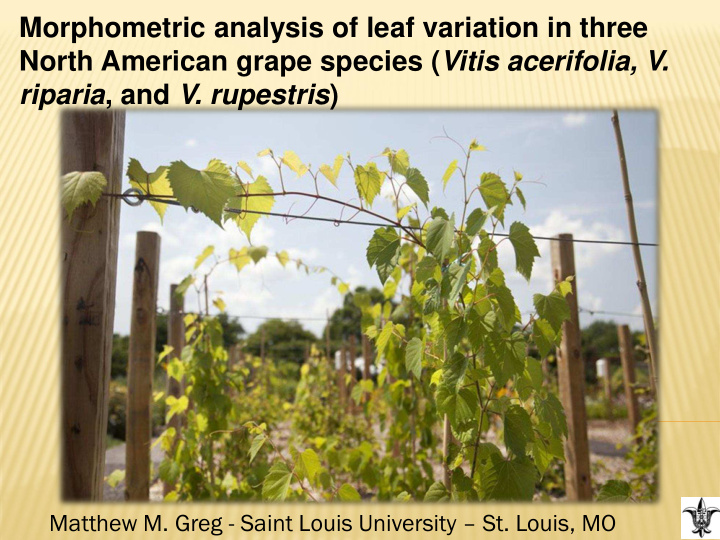



Morphometric analysis of leaf variation in three North American grape species ( Vitis acerifolia, V. riparia , and V. rupestris ) Matthew M. Greg - Saint Louis University – St. Louis, MO
OVERVIEW Introduction Research Question Objective Methods Results Discussion Future Work
WHEN YOU THINK OF GR GRAPES ES, WHAT DO YOU THINK?…
WHA HAT I NOW THI HINK NK AFT FTER ER THI HIS S SU SUMM MMER
INTRODUCTION Species within the genus Vitis (Vitaceae): Foundation of industries: Wine Table grape Raisin Grape juice Although grapevine cultivation is based primarily on the Eu Europe opean an grape apevine vine V. vini nifera era , North American Vitis species play an important role.
FAMILY: VITACEAE 12 genera: Other woody vines: Boston ivy ( q.v.; Parthenocissus tricuspidata ) Largest genus = Cissus 350 species Vitis Virginia creeper ( q.v.; P. 60-70 species quinquefolia )
GRAPEVINES Unusual crops because cultivated varieties often consist of tw two gene netica ticall lly y distinct tinct entit tities ies that are grafted together: Abo bove-ground part = scion Produces the stem, leaves, flowers, and berries Be Belo low-ground part = rootstock Forms the lower stem and roots
NOT A NEW IDEA Widespread grafting since the mid- 1800’s Why? Insects in the genus Phylloxera devastated the French grape industry. North American grapevines have been key genetic resources for the development of: Biotic and abiotic stress resistant rootstocks Hybrid grape varieties
TODAY Vineyards in France (and other regions) consist of: European V. vinifera grafted ed to North American Vitis species + =
WE CAN NOT IGNORE THE ROOT OF THE PROBLEM… Despite their importance for grape growing: Neglect of morphological variation in natural populations of Vitis species used for rootstocks.
FOCAL SPECIES: Noth American Vitis species: Bush or Maple leaf grape ( V. acerifolia) Bushy, covering shrubs or rocks in dry areas River or Frost grape ( V. riparia) Climbing up trees in moist soils Rock grape ( V. rupestris) Crawling in dry gravel creek beds
Miller/Mylers in review . V. rotundifolia V. sylvestris Eurasian species V. vinifera V. piasezkii V. coignetiae Asian species V. amurensis V. palmata V. labrusca V. aestivalis V. vulpina V. cinerea V. mustangensis North American species V. rupestris V. riparia V. acerifolia V. doaniana V. champinii V. monticola
Vitis acerif rifolia ia (Bush or Maple-Leaf) Original name, Vitis longii Native to panhandle area S econd in cold-hardiness among grapes only to V. riparia .
more Vitis ri ripa paria ria typical (River or Frost) Low woodlands near streams Heart-shaped leaves Forked tendrils Climbing vine Thick, woody vines with peeling, strip-like bark
Vitis ru rupe pestris ris (Rock) • Rocky soils near streams/ dry creek beds • Square/kidney-shaped leaves red stems, book-like • Broader ader than long folding of the leaves • Leaves often condupl duplicat cate (i.e., folding on itself) • Young stem stalks often red • Tendrils often absent (or forked) • Srub-like growth habit; rarely climb young, forked tendril
RESEARCH QUESTIONS V. acerifolia , V. riparia , and V. rupestris differ in the environmental conditions subjected to: Can these differences erences in mo morphology rphology be quantified? If so, can these measurements provide evidence for spe pecie ies de delim imit itati tion on?
OBJECTIVE The e pu purpose rpose of th this s st stud udy y is s to i identify entify mo morpholo rphological gical tr traits its th that t differ er amo mong ng three th ee closely osely rela elated ed Vi Viti tis sp spec ecies ies wh whose se natural tural dist stributions ributions differ er wi with th res espect pect to abi biotic tic con ondit ditions. ions.
METHODS Determine Characters: Standards- What has been done in the past? What appears most different? It is okay to go to the obvious Leaves in Vitis species exhibit striking diversity (Galet 1979)
METHODS Apply comprehensive morphological indices developed by: The International Organization of Vine and Wine (OIV) A Practical Ampelography: Grapevine Identification (Galet 1979) In order to: Characterize variation in 25 leaf af charact racter ers s in at least 10 acces cessions sions each of V. acerifolia , V. riparia and V. rupestris .
UNDERSTANDING THE DIFFERENCE…. Living Dead
METHODS Natural variation in leaf morphology is preserved through plant specimens housed in herbaria. ( V. rupestris) 117 specimens ( V. acerifolia) 24 specimens ( V. riparia) 505 specimens
METHODS Screen herbarium specimens Diverse geographic locations Complete
METHODS Locate the leaf to be measured: Maturity 1 ~Fourth node down 2 Seen in nature! 3 4 1 4 3 2 V. ripari ria V. acerfol olia ia
EXAMPLES OF DIFFICULTIES V. rupestris tris V. ripari ria
METHODS Take measurements:
Recommend
More recommend